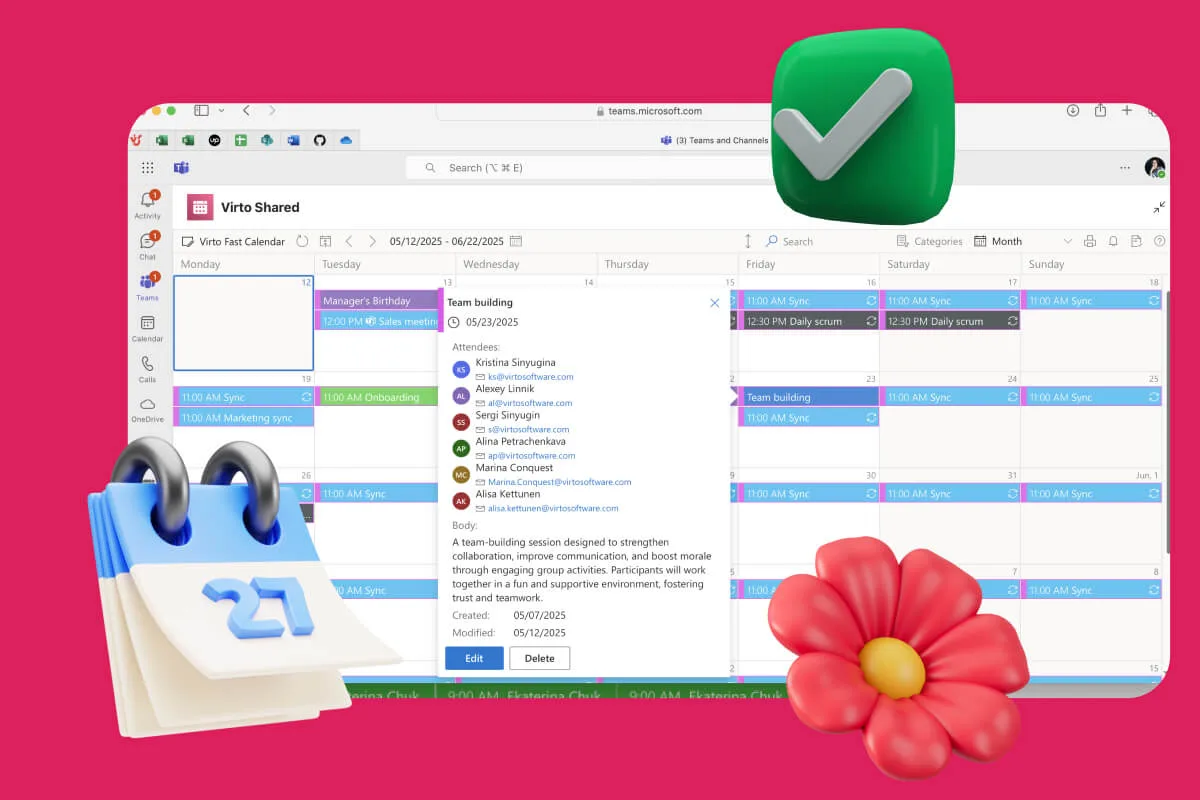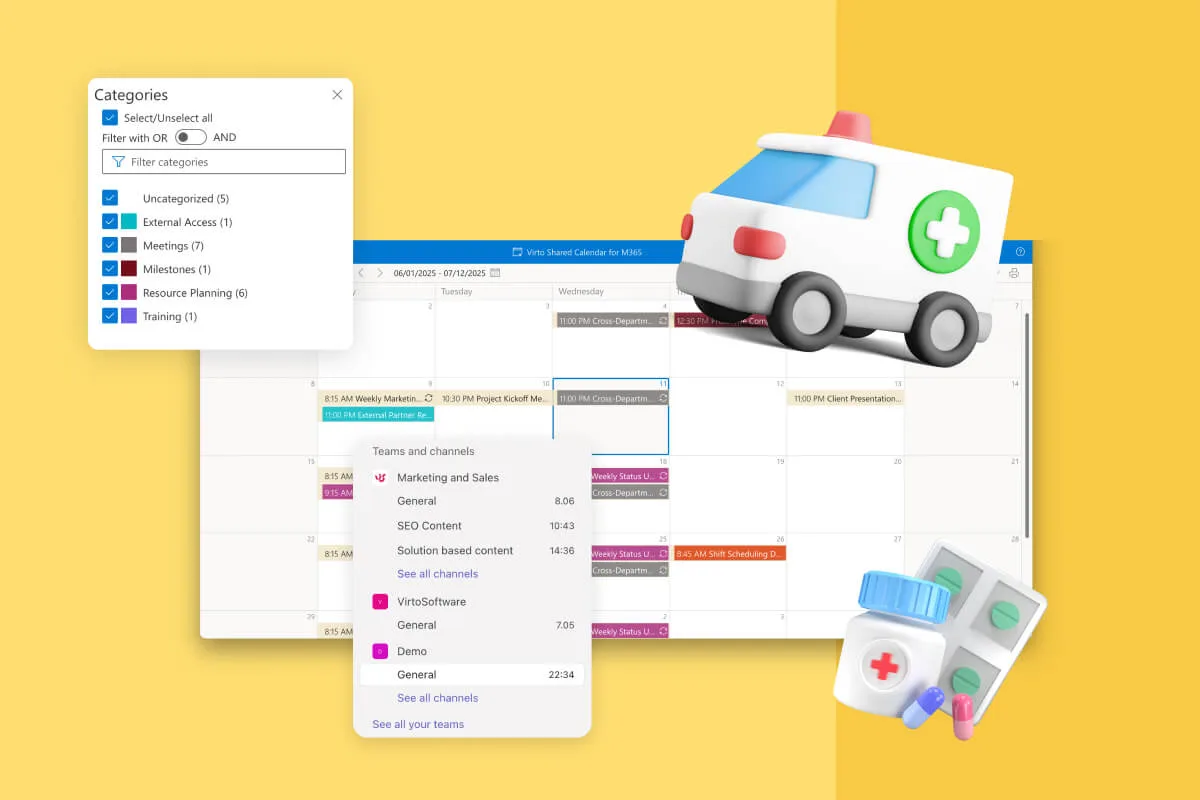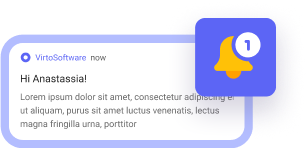Scheduling in healthcare is one of the most complex and mission-critical tasks in any medical organization. It’s a high-stakes balancing act where logistics, legal compliance, patient care, and staff satisfaction all hang in the balance. One wrong move, and you’re dealing with overtime chaos, regulatory headaches, or worse—disruptions in patient treatment.
And in today’s reality? The old-school, manual way of handling this is no longer cutting it. With growing patient loads, staffing shortages, and the need for fast, flexible decisions, trying to run a hospital schedule on spreadsheets is like trying to do surgery with a butter knife.
That’s why healthcare scheduling software has gone from “nice-to-have” to absolutely essential.
In this article, we’ll break down everything you need to know about scheduling software for healthcare organizations—from small clinics to large hospital systems:
- What different types of healthcare staff scheduling look like in action, and what they actually help you accomplish;
- Why switching to healthcare employee scheduling software (especially when it’s built to scale) can save hours of admin time and boost care quality;
- What to look for in tools like medical staff scheduling software, hospital employee scheduling software, and clinical staff scheduling software;
- A side-by-side look at some of the best staff scheduling software for healthcare teams on the market right now;
- Common mistakes to avoid when choosing and implementing staffing software for healthcare—because not all tools are created equal.
Whether you’re researching your first healthcare scheduling app or upgrading your current hospital staff scheduling software, this guide will help you cut through the noise and find a system that actually works for your team.
👉Start with discovering how scheduling works:
- Streamline Your Workforce with Advanced Staff Scheduling Software
- What Is a Cross Platform Calendar and How to Choose the Best One
What Is Healthcare Scheduling Software and Why Does It Matter?
So, what exactly is healthcare scheduling software?
In simple terms, it’s a specialized digital tool designed to take the chaos out of planning in healthcare. Think of it as mission control for organizing work schedules, patient appointments, on-call shifts, resource availability, and more—all in one platform.
Whether you call it hospital scheduling software, healthcare employee scheduling software, or staffing software for healthcare, the goal is the same: streamline complex workflows and keep everything running like clockwork.
Here’s what good scheduling software for healthcare helps you manage:
- Assigning shifts, working hours, and rotations for clinical and non-clinical staff
- Tracking time off, sick leave, emergencies, and last-minute changes
- Coordinating teams across departments, locations, or even entire healthcare networks
- Simplifying patient appointment scheduling—especially with multiple doctors and exam rooms in the mix
- Managing equipment, room availability, and other hospital resources in real time
Who’s using it? Pretty much everyone in healthcare.
- Clinics and outpatient centers use it to assign doctor schedules and appointment blocks
- Hospitals and inpatient facilities rely on it to manage shift rotations for nurses, physicians, admin staff, and surgical teams
- Diagnostic labs and imaging centers coordinate staff, patient flow, and equipment usage
- Private practices and ambulatory care centers depend on it to make the most of limited staff and keep things running smoothly
Whether you’re managing a small private practice or a large hospital system, healthcare staff scheduling software helps you cut through the complexity.

Why automate healthcare scheduling?
Manual scheduling isn’t just time-consuming—it’s risky. That’s why more facilities are switching to automated healthcare scheduling software.
Here’s what you get when you leave the spreadsheets behind:
✅ Lighter admin load
HR teams and clinic admins no longer waste hours juggling calendars. With staff scheduling software for healthcare, they can automate recurring shifts, use templates, and send real-time updates with zero hassle.
✅ Fewer errors, less chaos
No more double-bookings or shift overlaps. The system flags issues like overtime, regulation violations, or scheduling conflicts before they happen.
✅ Faster response to changes
A doctor calls in sick? A patient cancels last-minute? With a few clicks, the schedule updates, and everyone gets notified instantly. Flexibility like that is critical in busy hospital environments.
✅ Happier staff, happier patients
Predictable schedules mean less stress for your team. Automated reminders and clean appointment flows mean fewer no-shows and more satisfied patients.
✅ Better insights and control
From staff workload reports to time tracking and payroll data, medical staff scheduling software helps management make smarter decisions backed by data.
Common challenges solved by healthcare scheduling software
| Challenge | Impact | How scheduling software helps |
| Human error | Mistakes in schedules cause conflicts, coverage gaps, or care delays | Automated checks prevent overlaps, missed shifts, and double-bookings |
| Uneven workload distribution | Overworked staff or underutilized resources lead to burnout or inefficiency | Software distributes shifts fairly based on roles, availability, and regulations |
| Labor compliance risks | Violations like excessive hours or missed rest periods can lead to fines or staff dissatisfaction | Built-in rules ensure every schedule meets labor laws and internal policy |
| Lost or outdated data | Paper schedules and Excel files are hard to update, prone to conflicts | Centralized, real-time scheduling keeps data consistent and accessible to all staff |
Core Features and Use Cases of Healthcare Scheduling Software
Today’s healthcare scheduling software is more than just a digital calendar. It’s a multi-functional platform designed to manage workforce planning, coordinate patient appointments, connect with internal systems, and monitor actual working hours—all within one centralized interface. Whether you’re running a clinic, a hospital, or a mobile care unit, modern scheduling software for healthcare brings order to even the most complex environments.
Here’s what the best healthcare staff scheduling software can do.
Workforce management
| Feature | Description |
| Shift planning and role assignment | Build shift schedules by role (doctor, nurse, admin, support staff) using healthcare staff scheduling software. The system factors in qualifications, availability, preferences, and workload. Many solutions offer automatic shift generation based on rules. |
| Leave and absence tracking | Staff submit vacation, sick leave, and time-off requests directly via healthcare employee scheduling software. Approved absences update schedules in real time, reducing conflicts. |
| Automated reminders and notifications | Staff scheduling software for healthcare sends SMS, email, or app alerts to notify employees about upcoming shifts, changes, or urgent updates—reducing no-shows and boosting adherence. |
| Schedule version history | All changes are logged by hospital scheduling software, enabling managers to review past schedules, track edits, and resolve disputes. |
| Emergency replacements and shift swaps | When unexpected absences occur, hospital staff scheduling software quickly assigns substitutes and notifies everyone automatically to maintain coverage. |
| Certification-based task assignment | Assign tasks only to certified personnel (e.g., specialized nursing duties) with clinical staff scheduling software that tracks staff qualifications and restrictions. |
Patient appointment management
| Feature | Description |
| Online booking | Patients self-schedule through a healthcare scheduling app or online portal, easing the load on front-desk staff and reducing errors. |
| EHR and CRM integration | Scheduling software healthcare syncs appointments with electronic health records (EHR) and CRM systems, so providers have instant access to patient data alongside schedules. |
| Visual calendar by provider, room, or equipment | Quickly view doctor availability, room occupancy, and equipment schedules in hospital scheduling software to avoid overlaps and downtime. |
| Automated patient communication | Send SMS, email, or push notifications with appointment confirmations, reminders, cancellations, and instructions to improve patient engagement and reduce no-shows. |
| Group and specialized appointments | Schedule group visits like therapy sessions, vaccination clinics, or screenings using health care scheduling software with batch booking capabilities. |
| Mobile and field care coordination | Manage scheduling for home visits and mobile clinics with health care staff scheduling software that optimizes travel and visit timing. |
Time tracking & reporting
| Feature | Description |
| Work hour tracking | Track real attendance via badge readers, app check-ins, or manual input. This feature in employee scheduling software for healthcare ensures accurate payroll and compliance. |
| Automated reporting | Export detailed reports on hours worked, shift coverage, overtime, and department load. A core capability of staffing software for healthcare. |
| Compliance monitoring | Monitor work hour limits, rest periods, and labor law compliance automatically with staff scheduling software healthcare to avoid penalties and maintain safety. |
| Payroll and timesheet integration | Export scheduling data seamlessly to payroll and accounting systems using hospital employee scheduling software for fast, error-free compensation processing. |
| Schedule optimization analytics | Analyze how frequently schedules change, replacements occur, and conflicts arise to improve future planning using insights from healthcare scheduling software. |
Explore VirtoSoftware Calendar Solutions
Common Types of Scheduling in Healthcare
Scheduling in healthcare is diverse and must adapt to the unique needs of both staff and patients. Understanding the main types of scheduling helps healthcare organizations choose the right approach and tools, like healthcare scheduling software, to streamline operations and improve outcomes.
In this section, we’ll break down the most common scheduling types used for medical staff and patients — from shift patterns that keep hospitals running 24/7 to appointment slots that keep patient flow smooth and predictable.
Medical staff scheduling
In medical settings, shift scheduling is by far the most common method — especially in hospitals and emergency departments where round-the-clock staffing is essential.
Here are the main types of healthcare staff scheduling you’ll encounter:
| Type of scheduling | Description & examples | Where it’s used | Benefits / Notes |
| Shift scheduling | Patterns like “day/night/off,” “2 on/2 off,” “24 on, 72 off.” | Hospitals, ERs, ICUs | Ensures 24/7 coverage; predictable; easy to automate with healthcare staff scheduling software. |
| Flexible scheduling | Floating shifts based on staff preferences. | Clinics, diagnostic centers, private practices | Improves staff satisfaction; works well for part-time staff. |
| Rotating shifts | Alternates morning, evening, night shifts. | Large hospitals | Distributes workload evenly, but may disrupt sleep cycles. |
| Fixed scheduling | Standard daytime hours (e.g., 8:00–16:00). | Labs, admin departments, front desks | Ideal for support and non-clinical roles. |
| On-call scheduling | Doctors are on standby for emergencies. | Surgeons, anesthesiologists, specialists | Enables fast response in urgent situations. Works well with clinical staff scheduling software. |
Why is shift scheduling the most popular?
- 24/7 Operation: Hospitals and emergency units must never stop.
- Workload balance: Patterns like “24 hours on, 72 hours off” help prevent burnout and overwork.
- Easy automation: Shift scheduling fits well with hospital staff scheduling software, simplifying management.
👉 Learn more insights into shift scheduling in our recent guides:
- Shift Swapping: Practical Guides for Employees and Managers
- Availability Calendar Guide: Setup, Scenarios, and Templates
Patient scheduling
For patients, the most widespread scheduling method is appointment-based scheduling — assigning each patient a specific time slot based on the type of service and estimated visit duration.
This model is standard in hospitals, clinics, and private medical centers thanks to its simplicity, predictability, and ability to manage patient flow efficiently.
Key features of time-slot scheduling:
⏰Fixed time intervals: Appointments are booked in 10, 15, 20, or 30-minute blocks depending on the doctor’s specialty and visit type.
📊Predictability: Medical staff can plan their day in advance and balance workloads evenly.
⏳Reduced waiting times: Proper organization cuts patient wait times and avoids downtime for specialists.
⚙️Efficient resource use: Staff, rooms, and equipment are pre-allocated based on scheduled visits.
😊Patient convenience: Clear appointment times reduce no-shows and improve satisfaction.
Advantages of appointment-based scheduling:
✔️Easy to implement in both manual and digital setups, including healthcare scheduling software.
✔️Works seamlessly with electronic medical records (EMR/EHR).
✔️Balances workload among specialists and optimizes resource use
✔️Familiar and intuitive for both staff and patients.
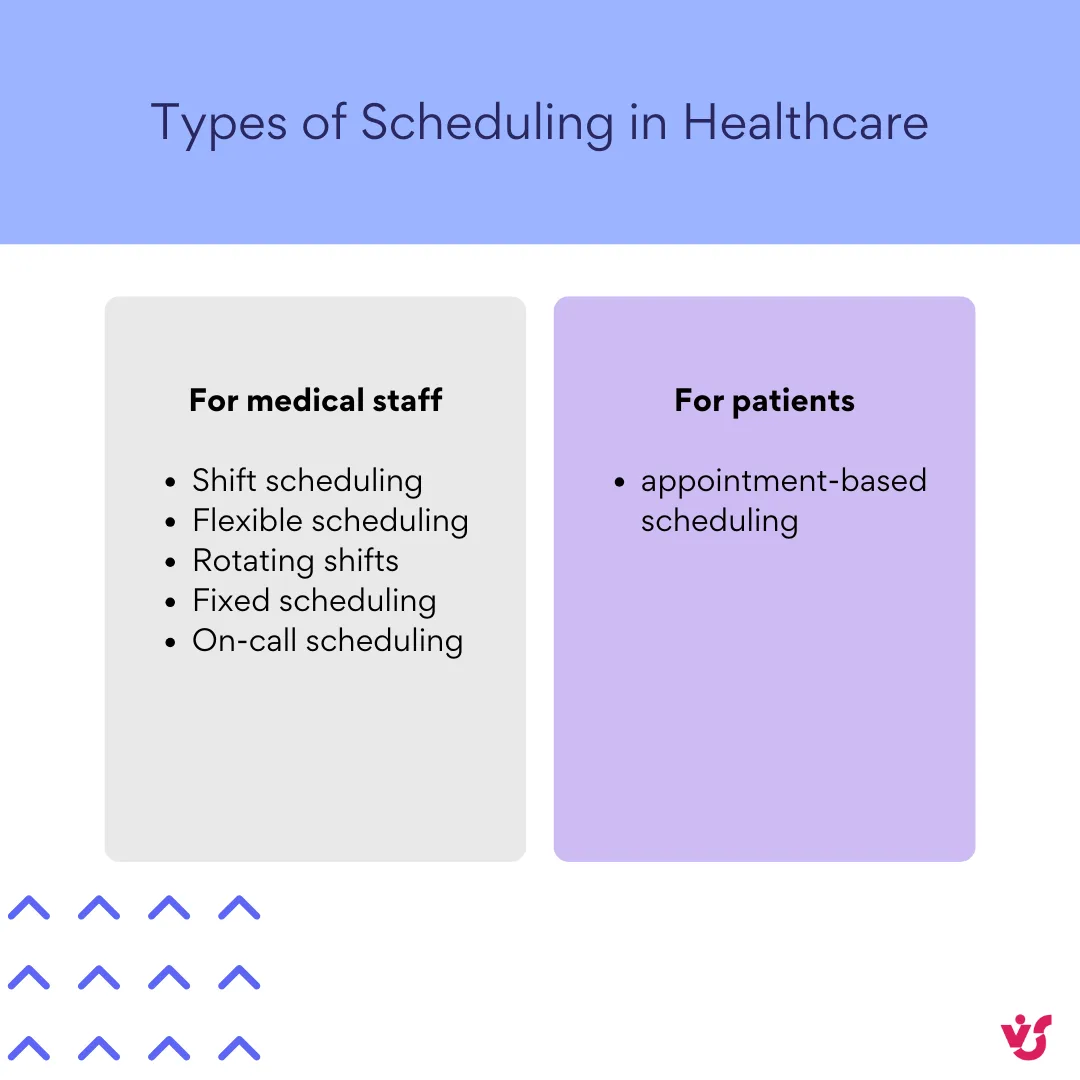
👉 What is the most common type of scheduling in healthcare? Appointment-based scheduling is the leading method for patient management, while shift scheduling dominates healthcare staff scheduling.
Types of Healthcare Scheduling Software & How to Choose
While the healthcare industry is full of different platforms promising better scheduling, not all tools are created equal. From shift planning to patient booking and compliance tracking, the right software can make or break your daily operations. Below, we break down some of the most widely used healthcare scheduling software to help you find the right fit.
Popular healthcare scheduling tools
As healthcare continues to digitize, more clinics and hospitals are replacing outdated manual scheduling with specialized healthcare scheduling software. These tools are designed to manage medical shifts, coordinate patient appointments, and automate complex planning processes.
Let’s take a look at some of the most widely used scheduling software for healthcare providers today — from hospital scheduling platforms to lightweight healthcare staff scheduling apps.
Here are a few notable names worth considering:
| Tool | Best For | Pros | Cons |
| Deputy | Small to medium clinics | Clean interface, great for staff scheduling, mobile-friendly, integrates with payroll | Not deeply healthcare-specific |
| Shiftboard | Hospitals and multi-unit care organizations | Powerful shift logic, strong reporting, built-in compliance tracking | Steeper learning curve |
| Kronos Workforce (UKG) | Enterprise healthcare networks | Advanced analytics, highly customizable, strong labor law compliance | Expensive and complex for smaller teams |
| Virto Shared Calendar | Microsoft-based healthcare environments | Seamless Microsoft 365/SharePoint/Teams integration, customizable views, HIPAA-ready | Best suited for organizations already using Microsoft stack |
| When I Work | Outpatient clinics and small medical teams | Quick to set up, intuitive UI, good for flexible staff scheduling | Lacks deep healthcare EMR integrations |
| NurseGrid | Nurses and mobile care teams | Designed for nurses, great for tracking availability and managing on-call shifts | Focused on individual/team level, not full hospital coordination |
| AMiON | Hospitals and specialist scheduling | Excellent for on-call rotation, physician-specific features, supports exports to calendars | Outdated interface and minimal analytics |
Compare scheduling tools for healthcare
| Criteria | Deputy | Shiftboard | Kronos (UKG) | Virto Shared Calendar | When I Work | NurseGrid | AMiON |
| Shift & flexible scheduling | ✅ | ✅ | ✅ | ✅ | ✅ | ✅ | ✅ |
| Staff availability & substitutions | ✅ | ✅ | ✅ | ✅ | ⚠️ Basic | ✅ | ✅ |
| Integration with other systems (EMR, HR) | ⚠️ Basic | ✅ | ✅ | ✅ (Microsoft 365, Teams, SharePoint) | ✅ | ⚠️ Limited | ⚠️ Basic |
| HIPAA/GDPR compliance & security | ✅ | ✅ | ✅ | ✅ (runs on secure Microsoft stack) | ⚠️ Depends | ✅ | ✅ |
| Ease of use / interface | ✅ | ⚠️ Complex | ⚠️ Complex | ✅ Intuitive + familiar UI | ✅ | ✅ | ⚠️ Basic |
| Reminders & notifications | ✅ | ✅ | ✅ | ✅ Outlook/Teams/email alerts | ✅ | ✅ | ✅ |
| Reporting & analytics | ⚠️ Basic | ✅ | ✅ | ✅ Built-in with Microsoft Power BI options | ⚠️ Limited | ⚠️ Minimal | ⚠️ Minimal |
| Pricing & scalability | 💰 Affordable | 💰 Mid-range | 💰💰 Enterprise | 💰 Flexible, scales with Microsoft licenses | 💰 Affordable | 💰 Affordable | 💰 Moderate |
👉What is the best software for healthcare? It depends on the size of the organization and your needs. For small clinics, tools like Deputy or When I Work offer simplicity. For larger providers, platforms like Shiftboard or Kronos offer full-scale healthcare employee scheduling software features and enterprise-level compliance.
👉What is the best scheduling software for healthcare workers? For frontline staff, apps like NurseGrid, Virto Shared Calendar and AMiON are user-friendly and focused on individual scheduling preferences and shift visibility.
How to choose the right healthcare scheduling software
Choosing the right staff scheduling software for healthcare comes down to understanding your organization’s size, structure, and digital maturity.
Here’s what to consider:
🖥️IT Infrastructure
Already using Microsoft 365 or SharePoint? Choose a healthcare scheduling app that integrates seamlessly — like Virto Shared Calendar, which works natively in Microsoft environments.
🏥Facility size & complexity
- Small clinics and private practices:
Prioritize ease of use, fast deployment, and user-friendly design. Tools like When I Work or Deputy are ideal.
- Medium to large organizations:
Look for hospital staff scheduling software that includes time tracking, reporting, and compliance controls — like Shiftboard or Virto.
- Hospital systems and networks:
You’ll need flexible, scalable solutions with role-based access and advanced analytics — Kronos (UKG) fits well here.
🔐Security & compliance
Choose platforms that support HIPAA, GDPR, encryption, and run in secure environments.
For healthcare providers, protecting sensitive data is a non-negotiable.
⚙️Functional needs
Are you just managing shifts? Or do you also need patient booking, time tracking, reporting, and integrations with other systems like EMRs?
Pick a solution that matches your full scope of operations.
👥Usability & staff adoption
The best staffing software for healthcare won’t help if your team won’t use it. Clunky interfaces kill adoption. Always test for usability and provide onboarding support.
Explore Our Use Cases for Healthcare Scheduling Software
Common Mistakes When Choosing and Implementing Healthcare Scheduling Software
Choosing the right healthcare scheduling software isn’t just a tech decision — it’s a strategic one. Get it wrong, and you could face operational disruptions, frustrated staff, scheduling chaos, and even a drop in patient satisfaction.
To help you steer clear of these pitfalls, here are some of the most common mistakes healthcare organizations make when selecting and rolling out staff scheduling software for healthcare — and how to avoid them:
❌ Ignoring the unique needs of your facility
Every healthcare organization is different. Whether you’re running a 24/7 hospital or a part-time diagnostic lab, your scheduling needs won’t be one-size-fits-all.
Some medical staff scheduling software solutions don’t support overnight shifts, split schedules, or role-based staffing rules. If your hospital staff scheduling requires minimum overnight coverage or rotating shifts, make sure your system can handle that logic — otherwise, you’ll be stuck manually patching the gaps.
📵 No mobile access = lower productivity
Your healthcare employees aren’t sitting at desks all day. Nurses, doctors, and admin staff are constantly on the move — between departments, floors, or even on house calls.
That’s why any modern healthcare staff scheduling software needs a responsive, easy-to-use mobile interface. A mobile app should allow staff to check their shifts, swap duties, or confirm appointments on the go — without waiting until they’re back at a workstation.
🧱 Complex interface = low adoption
Let’s face it: if your hospital employee scheduling software looks like a spreadsheet from 1999, people won’t use it.
No matter how feature-rich your scheduling software for healthcare is, a clunky UI will send your team running back to whiteboards, paper rosters, or WhatsApp chats. Look for intuitive, clean platforms that match your team’s digital habits — not just what looks good in a sales demo.
🔐 Ignoring compliance and security standards
In healthcare, data security isn’t optional — it’s mandatory. If your healthcare scheduling app doesn’t support HIPAA, GDPR, or local compliance frameworks, you’re putting patient privacy and your entire organization at risk.
Make sure your hospital scheduling software includes built-in access controls, data encryption, and audit trails — especially if it handles patient bookings or integrates with EMR systems.
🆘 No support or onboarding plan
Even the best employee scheduling software for healthcare will fail without proper onboarding.
Lack of training, poor rollout plans, and weak vendor support can leave your staff frustrated and disconnected from the tool. Choose providers who offer detailed documentation, live onboarding, and ongoing support — especially in mission-critical environments like hospitals or clinics.
Bottom line?
Smart, scalable, and compliant healthcare staffing scheduling software doesn’t just simplify timetables — it keeps your teams aligned, your patients cared for, and your operations future-ready.

How Virto Shared Calendar App Supports Healthcare Scheduling
If your team is already working in Microsoft 365, the Virto Shared Calendar App is a powerful and secure way to manage scheduling for clinics, hospitals, and medical teams. It acts as an all-in-one healthcare scheduling software solution — right inside the tools your staff already uses every day, like Outlook and Microsoft Teams.
From shift planning to task coordination and patient scheduling, here’s how Virto helps streamline healthcare operations.
🩺 Shift & staff scheduling made simple
Virto works as intuitive and flexible healthcare staff scheduling software that helps you:
📆 Visualize shifts directly in a shared calendar, with color-coded roles, departments, or zones
🎯 Filter by team, role, or location to easily view who’s working where and when
🔔 Send automated reminders about upcoming shifts, on-call rotations, or last-minute changes
🔁 Set up recurring schedules for regular shifts and cover overnight duties with ease
It’s a reliable option whether you’re managing hospital staff scheduling, clinic coverage, or lab teams.
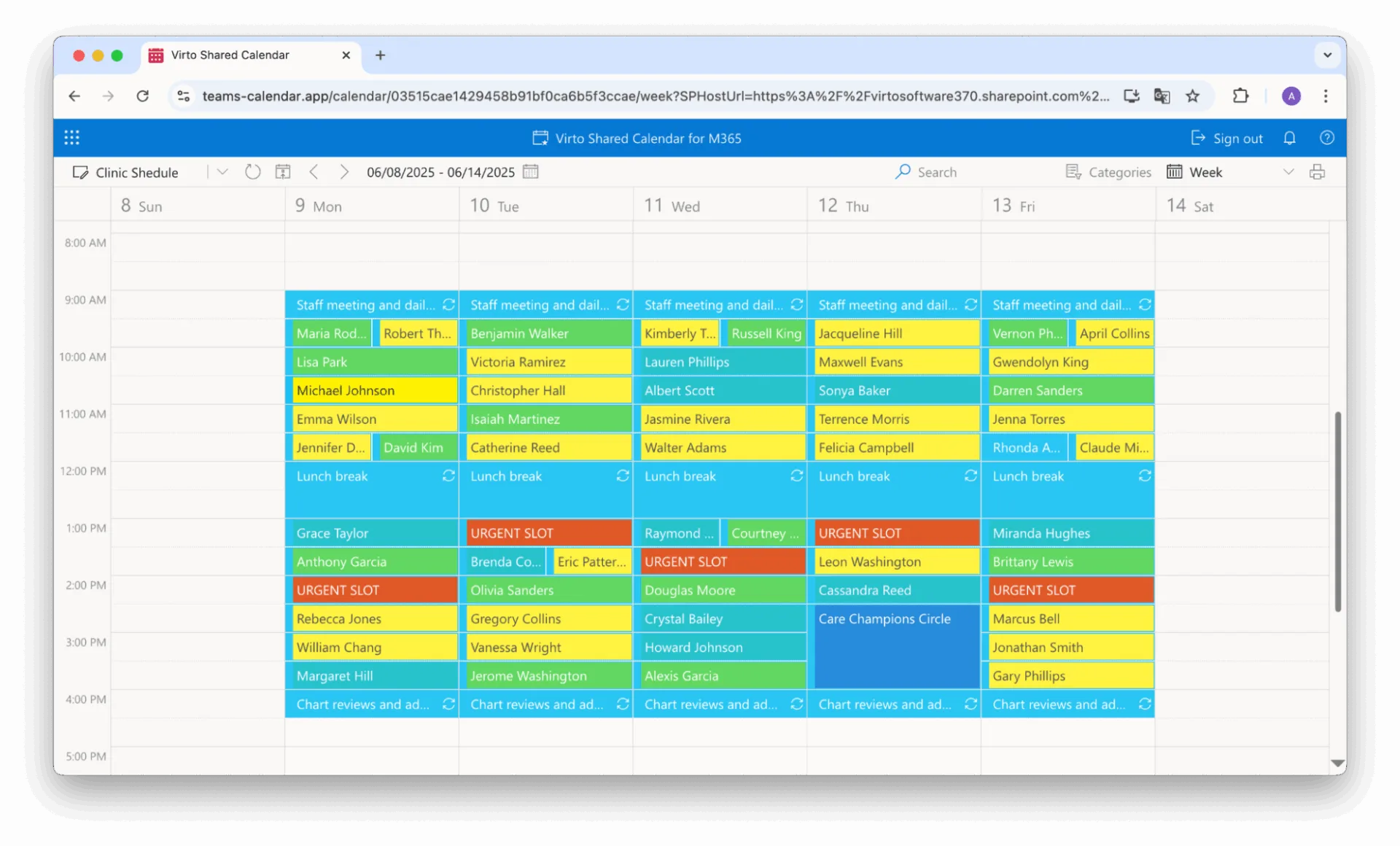
🤝 Coordination between people, rooms & tasks
With Virto, scheduling software for healthcare isn’t just about assigning hours — it’s about coordinating people, appointments, and workflows:
👩⚕️ Schedule multi-participant events, such as patient + doctor + equipment + room
📌 Assign tasks and deadlines to nurses, admin staff, or doctors — and track progress
🔄 Sync instantly with Microsoft Outlook, Teams, and other Microsoft 365 tools
Whether you’re running daily standups, scheduling surgery blocks, or managing a mobile unit — it’s all in one place.
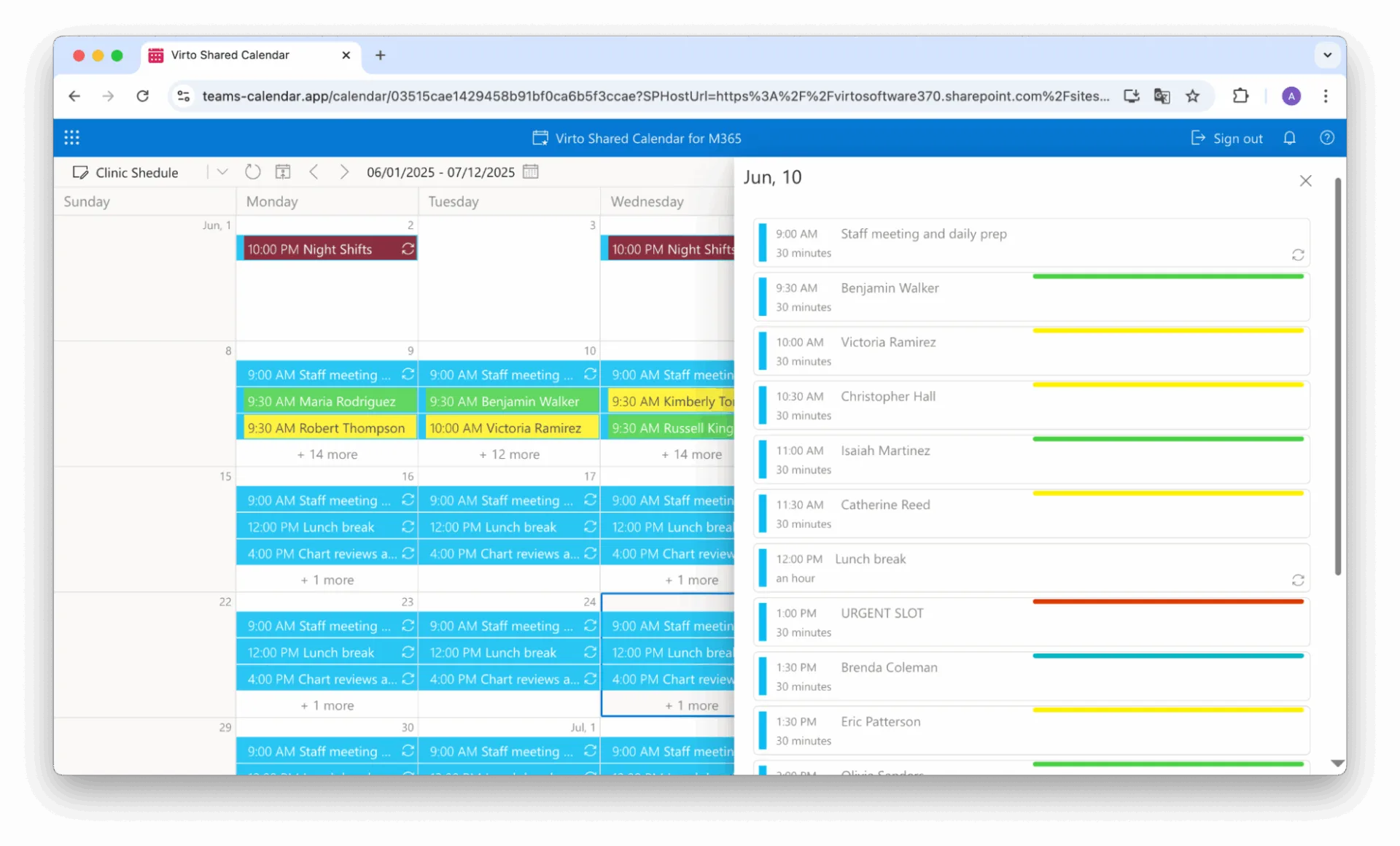
💬 Team collaboration without the chaos
Virto Shared Calendar App doubles as collaborative staff scheduling software for healthcare, built for how real teams work:
🧑⚕️ Custom access levels based on user role (physician, coordinator, assistant, etc.)
💬 Comment on events, track changes, and view scheduling history
🧭 Stay inside Microsoft Teams — no app switching needed
It brings clarity to healthcare employee scheduling software — especially when teams span multiple departments or shifts.
🔐 Built-in security & HIPAA compliance
Trust is everything in healthcare. Virto Shared Calendar App is built on Microsoft 365’s secure infrastructure, making it a great choice for compliance-conscious environments:
🔒 HIPAA-ready, with encryption for both stored and in-transit data
📊 Activity logging and role-based access to align with internal security policies
✅ Keeps your healthcare staffing scheduling software fully compliant with GDPR and other global standards
👥 A better scheduling experience for patients
While Virto Shared Calendar App is built for staff, it also improves the patient-facing side of healthcare scheduling:
🌐 Integrate with your online booking system, so patients can see available times and book online
📩 Send automated reminders about upcoming appointments
✅ Reduce no-shows and improve engagement with transparent, accessible calendars
🧘♀️ Help your patients feel more in control, supported by better coordination
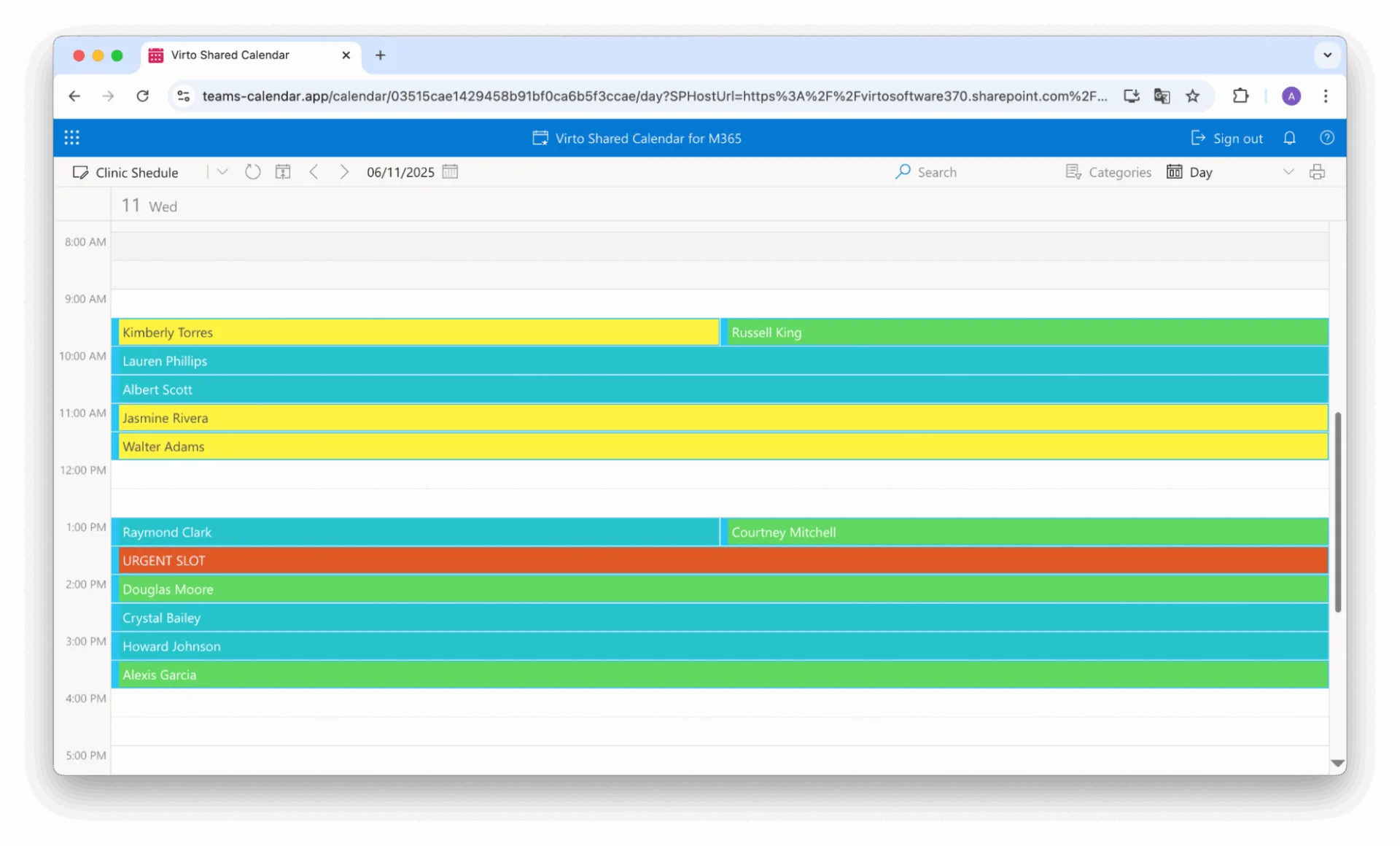
Virto Shared Calendar App isn’t just another clinical staff scheduling software tool — it’s your all-in-one calendar hub inside Microsoft 365, designed for the way modern healthcare teams plan, collaborate, and care.
👉Gotta see it to believe it? Check out how it all works in practice:


